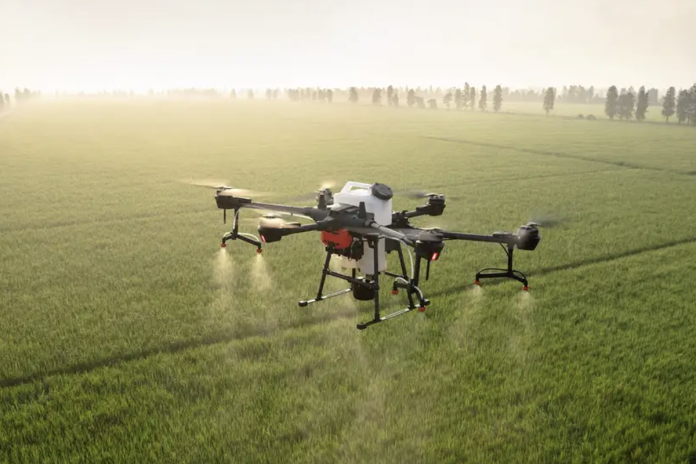- The survey recommends improving the efficiency and viability of airlines, imbibing environmental sustainability, and ramping up long-haul flights by Indian carriers.
To sustain its position as one of the world’s fastest-expanding aviation markets, India must increasingly tap into the potential of emerging growth areas of drones, aircraft leasing and MRO, the Economic Survey for 2023-24 has said.
Released on Monday (22 July) by Union Finance Minister Nirmala Sitharaman, the survey notes that drone or unmanned aerial vehicles (UAVs) have comprehensive usage across sectors such as agriculture, healthcare, disaster relief, surveillance and defence.
Besides announcing liberalised drone rules in 2021, the country has also rolled out initiatives such as drone airspace maps, a production linked incentive (PLI), and a drone certification scheme for the segment. This has resulted in the setting up of 109 training organisations and the issue of over 10,000 drone pilot certificates.
The promotion of aircraft leasing through the International Financial Services Centres (IFSC) at the GIFT City near Ahmedabad has resulted in 28 aircraft leasing companies setting up shop there.
So far, these companies have leased more than 20 aircraft and 49 engines. The national flag carrier Air India has commenced leasing widebody aircraft from the IFSC, while other major domestic carriers have also initiated the process of establishing leasing entities there.
The survey also urges India’s maintenance, repair and overhaul (MRO) segment to be developed to rival its global peers. It notes that the number of MROs increased by more than 22 per cent to 147 from 114 in 2016 when the National Civil Aviation Policy was announced.
The companies in the segment have also enhanced their capacities to spread their wings beyond traditional segments such as airframes to enter activities requiring a higher degree of specialisation such as engines in collaboration with global original equipment manufacturers like Airbus and Boeing. More airports are also adding MRO facilities at their premises.
Reacting to the survey, Saleel Arora, co-founder at the New Delhi-based law firm AviLeague Partners said, “After substantially upgrading [aviation] infrastructure over the last few years, the government is rightly shifting its focus on promoting newer technologies to build a comprehensively self-sufficient ecosystem for the domestic aviation industry.”
Navigating Headwinds
But some serious headwinds need to be navigated along the way, a cross-section of industry insiders and experts told Swarajya. In the drone segment, for instance, stakeholders feel it’s time to tweak the PLI scheme to meet the supply-side challenges for components.
Even as India has witnessed the emergence of several drone manufacturers, critical parts such as electronic chips, batteries and motors continue to be imported.
This needs to be resolved by incentivising local component makers to scale their production through PLI schemes, leveraging capabilities in allied industries like electric vehicles and space, and creating drone manufacturing and testing clusters to encourage entrepreneurship and close partnerships.
Similarly, India’s aspirations to become a global aircraft leasing hub will be on hold until Indian Parliament ratifies the Cape Town Convention Bill. This bill has been pending since 2018 and is a necessary step towards competing with established hubs like Dublin and Singapore.
Concluded way back in 2001, the primary aim of the Cape Town Convention and Protocol is to resolve the challenge of obtaining certain and unopposable rights to high-value assets such as airframes, aircraft engines and helicopters that, by their very nature, have no fixed location.
While India became a contracting state to the convention in 2008, some of its provisions conflict with the country’s bankruptcy laws. Interestingly, India today stands alongside Afghanistan and South Africa among only three nations that have not aligned their legal framework with it.
Consequently, leased aircraft of the bankrupt low-cost carrier Go First are still parked at various airports in the country, with the international lessors fighting to repossess them in Indian courts.
Meanwhile, the recent announcement by the Ministry of Civil Aviation to charge a uniform integrated goods and services tax (IGST) of 5 per cent on all aircraft and aircraft engine parts is expected to provide a significant push to the MRO segment.
Insiders further recommend the industry be treated as a composite service for GST calculation. This would not only help players to reduce operational costs but also encourage more domestic and international investments.
The survey also says that despite the doubling in airport capacity and impressive growth witnessed in the air travel market since 2014, the full potential of the aviation sector continues to be largely untapped.
“At around 0.13 air trips per capita, the current passenger air traffic is a fraction of India’s potential,” said the survey.
Initiatives such as the International Aviation Hub Strategy and engagements with global bodies will help the country emerge as a leading player.
It also recommends improving the efficiency and viability of airlines, imbibing environmental sustainability and ramping up long-haul flights by Indian carriers to prevent their losing passenger traffic to competitor airlines in the Middle East and Southeast Asia.


